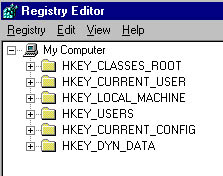The Windows 95 Registry consists of six root keys, each of which reflects a different aspect of the configuration. Each key or branch of the Registry groups information that logically belongs together. All top-level keys are called root keys and defined and named by Windows 95. These cannot be changed. Root keys are named HKEY_XXX and can be followed by several subkeys. All other keys in the Registry are subkeys of these six primary keys. Subkeys can be added, deleted, or renamed. The six root keys are shown in Figure 16.5 and are explored in the following sections.

Figure 16.5 Registry root keys
HKEY_CLASSES_ROOT
This section of the Registry defines the standard-class objects used by Windows 95. Do not make any changes to this section. This is a link to the HKEY_LOCAL_MACHINE\SOFTWARE\Classes, which simply provides compatibility with the Windows 3.1 registration database. This compatibility is important if you want to run Windows 3.1 16-bit applications in Windows 95.
HKEY_CURRENT_USER
This section defines the current user settings-it's not important for repairing computers. Personalized information like fonts, some icons, and colors can be changed here. This is a link to the HKEY_USERS key. This key provides Windows 95 compatibility to applications using the Windows NT Registry structure.
HKEY_LOCAL_MACHINE
This portion of the Registry contains all the data for the system's non-user-specific configurations (including every device in the computer). This is the largest key in the Registry and the place you will perform the bulk of your system edits to optimize Windows 95 performance. Information stored here includes hardware configuration, peripheral devices, installed software, OLE compatibility, software configuration, and Windows 95 configuration. The data stored in HKEY_LOCAL_MACHINE is stored in the SYSTEM.DAT file.
HKEY_USERS
This section of the Registry is where Windows 95 keeps track of the different user settings. If your computer is not configured for multiple users, you will have a single subkey named DEFAULT. If your computer has been configured for multiple users, two profiles are created when you log on: HKEY_USERS\.DEFAULT and HKEY_USERS\user name\user.dat. If it's a two-user system, the other user's settings are held in memory. This makes it impossible to alter user settings without logging on under their name and password.
HKEY_CURRENT_CONFIG
This key handles Plug and Play and contains information about the current configuration of a multiple-hardware-configured computer. This key works in conjunction with HKEY_LOCAL_MACHINE\Config\xxxx, where xxxx is the subkey that represents the numeric value of the current hardware configuration.
HKEY_DYN_DATA
This is Registry data that is stored in RAM to speed up system configuration. A snapshot of all hardware in use is stored here. It is updated on boot up and when any changes are made in the system configuration file. This portion of the Registry is dynamic. It's where virtual device drivers are installed, where Plug and Play hardware information is maintained, and where performance statistics are calculated. Because this information is accessed and changed constantly, this portion of the Registry is never written to the hard disk. It resides in the computer's RAM.